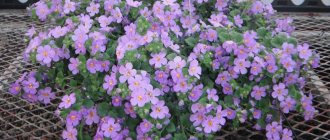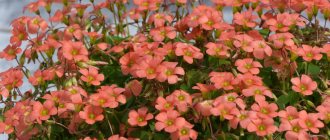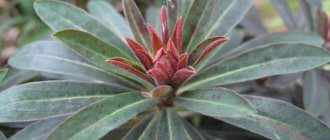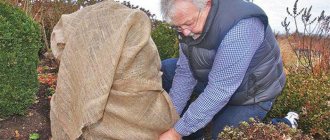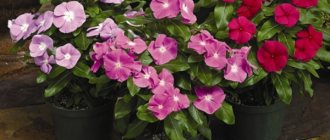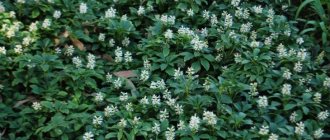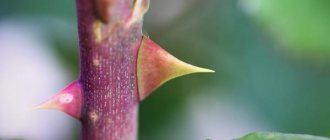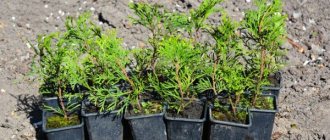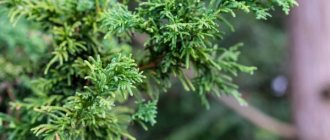The dream of every gardener is to turn a summer cottage into an original, cozy corner. Beautifully flowering plants will help improve the space. Unlike spirea, tree hydrangea, and viburnum Buldenezh - shrubs that have long become popular, three-lobed Louiseania is rare in our latitudes. The ornamental tree was first brought to Europe by the British in the mid-19th century. The spectacular plant is hardy, unpretentious and easy to propagate, so it easily wins the hearts of gardeners.
Description of the plant
A low, decoratively flowering perennial stone fruit shrub of deciduous type belongs to the Rosaceae family.
The height of a spreading, multi-stemmed shrub is no more than 3 m, depending on the climatic zone of cultivation. The crown is spherical, the shoots sticking out are dark gray. The leaves are 6-8 cm long, matte, with noticeable depressed veins, and coarsely toothed along the edges. Louiseania triloba received its name because of the characteristic shape of the leaf blade - one blade at the tip of the leaf, two on the sides. During flowering, the branches of the Louiseania bush are densely and abundantly covered with flowers 1.5-2.5 cm in diameter. The color of the petals varies from pale pink to crimson, the flowers have many stamens and one pistil. The flowers are grouped in pairs; natural species have simple flowers, while varieties have double flowers. An abundance of flowers is observed on young branches; on old branches the covering of flowers is not so thick and dense. Flowering begins in May and lasts up to 2-2.5 weeks, after which the petals fall to the ground and the leaves begin to bloom.
Due to the fact that in May the bush is covered with pink flowers, it is often confused with a cherry, but the plant has nothing to do with it.
In addition to its decorative benefits, almonds are able to strengthen soils near slopes and cliffs with their root system. With proper planting and care, the bush can live in one place for many decades.
In autumn, at the end of September - beginning of October, the leaves acquire various shades of red, red, yellow, and the bush becomes bright, colorful, and elegant.
The fruit is a drupe, round in shape, about 1 cm in diameter, with a dry, velvety-pubescent pericarp and a hard-to-separate stone.
Light-loving, heat-loving, frost-resistant plant. The bush is able to withstand a moderately frosty, snowy winter. If temperature fluctuations are large during the cold period of the year, they can greatly harm the bush. In very severe and prolonged frosts, shoots and root collars may be damaged. To preserve Louiseania, especially in the middle zone, it is recommended to cover it for the winter.
Nuances of growing in the Moscow region
Although Louiseania is a heat-loving plant, it can easily tolerate frosty and snowy winters . Some sources claim that with proper preparation for winter, it is not afraid of frosts down to -30. However, the problem may be sudden or frequent changes in temperature, especially if frost is replaced by damp thaws. In this case, the plant wakes up prematurely and may be damaged by frost. The ends of its shoots and buds freeze. In such cases, almonds should be covered throughout the frost. Having followed the above recommendations, problems should not arise when growing almonds in the Moscow region.
Types and varieties of almonds
About 200 types of almonds are known. Hybrid varieties are grown in gardens and household plots; they are more decorative than natural species, the flowers are larger and have double shapes. Triloba almond, due to its magnificent bright early flowering, is very valuable among flower growers. Three-lobed almond is an unpretentious plant that will reward you with a healthy appearance and bright flowering for simple care and care. Species and varieties of Louiseania with simple flowers are rarely grown in gardens and used in landscaping garden plots; it can be seen in various nurseries and botanical gardens.
Georgian almonds
Georgian almonds
Endemic to the mountainous regions of the Caucasus, it prefers light mountain slopes, ravines, and forest edges. Heat-loving variety, less winter-hardy. Deciduous bush no more than 1 m, with a dense spherical crown. The leaves are alternate, oval or linear-lanceolate, about 5-8 cm in length, tapered at the end and at the stem.
The flowers are single, axillary, large, with bright pink petals, bloom simultaneously with the leaves. The fruit is a rough, hairy drupe. Flowering begins in April-May, lasts about two weeks, the first flowering is observed at three years.
Decorative almond pink foam
almond “Pink foam”
Bush 1.5-2 m high. One of the most popular almond varieties among flower growers and landscape designers. The flowers are double, about 1-2 cm in diameter, pink, arranged in pairs on the branch, and resemble miniature roses in appearance. Flowering begins 3-4 years after planting. Frost-resistant species, easily tolerates severe frosts -25...-40°, however, for young plants in the first year of life, shelter is necessary.
Common almond
Common almond
A tall species, it is a spreading large shrub or low tree up to 4-8 m in height, similar in appearance to a cherry. It is found in the Caucasus, Crimea, Central Asia, countries of the Mediterranean Sea, Afghanistan and Iran.
The leaves are petiolate, up to 4-6 cm long, lanceolate, elongated, with a long pointed apex, glabrous, the edges are blunt-serrate-toothed. The flowers are about 1.5-2.5 cm in diameter, solitary, white or pink, and bloom before the leaves. The fruit is a drupe, 3.5 cm long, oval with a green or gray-brown color, pubescent, ripens in July, appears at 3-4 years of age. The shrub is found in two forms, differing in the taste of the seeds - bitter almonds and sweet almonds.
Petunnikova
Petunnikova almonds
Endemic to Central Asia (Western Tien Shan). A low deciduous bush no more than 1 m high. The crown is formed by splayed, straight, smooth, thin, densely leafy branches of gray-brown or light brown color. The leaves are up to 3 cm long, elongated, lanceolate, pointed towards the apex, smooth, with a sharp serrate-toothed edge on short petioles.
The flowers are up to 2 cm in diameter, solitary, white-pink, densely clinging to the branches, blooming in April-May simultaneously with the blossoming of the leaves. The fruits are 1-2 cm long and ripen in late July - early August. Frost-resistant variety, survives cold temperatures down to -30...-35°. Little known in culture, rarely used in landscaping, mainly grown in botanical gardens, protected in nature reserves.
Terry Stonefly
Terry almonds Vesnyanka
The height of a bush or low tree is 2-3 m, the crown is spreading. Flowering begins in late April - early May, duration 15-20 days. The flowers are up to 3 cm in diameter, fragrant, single, sometimes in pairs, double, resembling roses, soft pink with a beige tint; by the end of flowering the petals turn pale, becoming almost white. The leaves are three-lobed, bloom bright green with a pubescent lower side, and gradually acquire a dark green hue. In autumn they turn bright yellow-orange. Louisiana stoneflies fruit set, but in most cases fall off unripe.
Almond variety “Tanyusha”
It is an early flowering variety. It is distinguished by a large, densely double structure of flowers up to 25-35 mm in diameter, consisting of wavy, twisted crimson petals. Shrub up to 2 m in height, with a spreading crown and gray-brown branches. It is considered one of the most super terry varieties. The leaves of the Tanyusha almond are coarsely toothed, lanceolate, elongated, green in color. Flowers bloom in early May, flowering lasts up to three weeks.
Ledebura
Ledebour almond
This almond variety comes from Altai. Prefers light steppe plains, mountain slopes, river valleys, fields, and is distinguished by early flowering and large leaves. It does not tolerate frost well and freezes over in winters with little snow, but thanks to the abundant root growth it quickly recovers. Deciduous bush no higher than 2 m, with a spherical crown.
The leaves are large, dark green, 5-7 cm long and up to 2 cm wide. The flowers are pink, flowering lasts up to 3 weeks. The fruit is a drupe 4 cm long.
Dessert almonds
Dessert almonds
The height of the plant is 3-4.5 m, the branches are thin, hanging, forming a rounded dense crown. It blooms in the first half of April, the fruits ripen mid-early (mid-September). The fruits are large, edible, the average nut size is 35x23x16.5 mm, the kernel is easily separated from the shell. The taste of the kernel is sweetish and oily. Very often, two-core fruits are formed. An adult tree produces an average of 10-15 kg of nuts.
Double three-lobed roseamund
almond double three-lobed rosemund
Compact low shrub up to 3 meters in height. It has a longer flowering period. The flowers are large, 2.5-3 cm in diameter, double, solid pink, the flowers are sterile, they do not form fruits. The Rosamund variety begins to flower in mid-April, lasting about 1 month.
After flowering, the leaves bloom. In hot weather, the flowering time is shortened. Frost-resistant species, withstands -25...-27° frost. Flowering begins at 2-3 years of age.
Steppe low bean
Winter-hardy variety, adapted to the middle zone. A low bush, branched, deciduous, 1-1.5 m high with a compact spherical crown, linear-lanceolate or broadly elliptical dark green leaves. The flowers are fragrant, large, single, deep pink, bloom simultaneously with the leaves. The fruit is an inedible, felt-covered drupe, up to 2 cm long. All parts of the plant are poisonous. The plant produces a lot of young shoots. Light-loving, drought-resistant variety, can grow on rocky soil. Flowering lasts 1-2 weeks.
Growing in the Urals and Siberia
Everyone considers almonds an exotic plant that loves sun and warmth and needs special care. However, this is nothing more than a misconception. Of the about 40 species of this plant, most do not require a special climate or other conditions.
Although almost all types of almonds are frost-resistant and not particularly demanding on the soil, not all are suitable for growing in Siberia and the Urals. There is one type of plant that is suitable for the northern regions, this is the steppe almond. It is also called bean, wild and low almond.
Like other almond species, its flowers are a deep pinkish hue and bloom for about 2 weeks in early May. After the flowering period, it becomes covered with leaves, and at the end of summer, chestnut-colored fruits appear on it. The bean plant grows up to 1.5 meters in height. It needs enough light and shelter from the wind.
Caring for steppe almonds does not differ from the care given above for three-lobed almonds.
Outdoor care
Three-lobed almonds are quite easy to grow. The rules of care are simple and consist of weeding, loosening, pruning, and watering.
Water the plant periodically moderately; during the flowering period of the bush, more water is required than at other times, the duration of flowering depends on this. In moist soils, moderate, even infrequent, watering is required. When growing almonds, water strictly under the trunk; water on the above-ground parts of the plants can cause burns of leaves and flowers. Loosen and remove weeds around the trunk 2-4 days after watering.
If necessary, Louiseania is transplanted to another place; the procedure is carried out in August. The plant tolerates transplantation calmly.
The bush is frost-resistant, however, shelter for the winter will not hurt; the branches are tied into a bundle, wrapped in woven material, and the soil around the trunk is mulched with peat.
Feeding and watering
Almonds are a fairly drought-resistant plant. During flowering, the bush requires abundant watering, regardless of the composition of the soil on which it grows. In the future, a bush on sandy soil requires more watering than on clay soil. Overmoistening of the soil and stagnation of water can cause rotting of the root collar. The plant needs water when the soil dries to a depth of 1.5-2 cm.
Fertilizing is applied after the flowering period, using organic fertilizers (compost, humus). 7-14 days after fertilizing, a urea solution is introduced into the soil. One bush will need 10 grams of fertilizer per bucket of water. In the fall, apply no more than 50 grams of mineral phosphorus fertilizers (superphosphate or wood ash at the rate of 1 glass per bucket of water) and dig shallowly. With the onset of winter, the soil around the trunk is mulched with peat or leaf humus (5-6 kg per bush).
How to prune a bush correctly
Almonds easily tolerate decorative and sanitary pruning, which is necessary for the formation of the crown and the health of the bush. Pruning is carried out annually, starting from the age of two years of the plant. As soon as the bush fades, all branches are shortened by 2/3 of their length. This procedure stimulates the growth of new shoots. Branches growing deep into the crown are pruned. They contribute to thickening of the crown, which reduces the degree of ventilation of the bush, and as a result, diseases can begin. Sanitary pruning is carried out in early spring before the flower buds begin to swell. Remove dried, frozen branches and shoots.
Three-lobed almonds - care
During the period of decorative flowering and subsequent summer growth, Louiseania spends a lot of energy. Periodic application of nutrients and proper care will turn the three-lobed terry almond into a luxurious and healthy bush. The main activities include the following points:
- It is recommended to fertilize the melting snow cover with humus (up to 6 kg/bush) or mullein solution (1:10).
- Feeding with complex preparations after pruning (up to 40 g/bush).
- Top dressing in August with superphosphate (up to 20 g/m²).
- Regular watering in the spring up to 3 buckets/bush twice a week, but stagnation of moisture and water entering the crown should be avoided.
- Mulching the soil with peat or compost.
- Removal of root shoots not used for propagation.
Diseases and pests
In most cases, almonds are quite resistant to diseases and attacks by insect pests. However, with changes in external conditions, errors in care and maintenance, the plant may be attacked by leaf roller or plum borer. They are fought with the help of karbofos.
More often than others, aphids settle on the bush. A solution of laundry soap, an infusion of tobacco or potato tops helps. Plum sapwood bark beetle may appear on adult bushes; the insect itself is not dangerous to the plant, but by making passages and holes in the bark, this action creates a threat of fungal diseases. To combat, the trunk of the bush is smeared with a lime-clay solution with the addition of bustylate or wood glue.
Often a tit becomes an unwitting pest. In early spring, slightly swollen flower buds become almost the only food available. Only the decorative appearance suffers from the “raids” of birds. Many people place bird feeders to avoid “attacks” and to distract them from almonds.
Among diseases, gray mold is of greatest danger. If affected shoots are detected, they are pruned (after flowering and in winter), the main thing is to have time to prevent the formation of gray pads.
Moniliosis is a fungal disease that enters a plant through a flower. In this case, spores that get inside lead to massive drying out of the affected shoots, they acquire a dark color, lose their decorative appearance, becoming like burnt wood. Prevention of the disease consists of spraying flowers with antifungal drugs. In case of infection, remove the affected branches.
As a result of insufficient care and unsuitable maintenance conditions, when the bushes are not pruned, planted in the shade, and last year's leaves are not removed, the plants are affected by monilial burn, rust, and hole spotting. To prevent such diseases, plantings are not choked, proper care is taken, and the bushes are sprayed with a colloidal aqueous suspension of sulfur.
In the southern regions, infection occurs with a little-studied infectious disease - milky sheen or silverfish. The fight against such a disease is often useless; plants are uprooted and burned. As a precautionary measure, all cuts and wounds of the tree are disinfected and lubricated, the trunks are whitened, old leaves and rotting wood are removed.
Fruit
Hairy, rounded drupes about two centimeters in diameter, colored red. When ripe, the mesocarp opens to reveal the reticulated endocarp.
In Europe and China, the standard crop of Louiseania triloba (rosenmund) has gained popularity. It is an elegant tree with a ball-shaped crown, which consists of protruding young shoots. Immediately after the plant fades, it is cut into a crew cut, giving the opportunity to grow young shoots and lay new flower buds.
We have already said that people sometimes call Louiseania three-lobed Siberian sakura, although this plant has no common ancestors with cherries. And this is due not only to the frost resistance of the plant. This comparison is endowed with a special philosophical subtext - the bright, but at the same time short-lived beauty of the bush symbolizes, as in the case of Japanese sakura, the transience of life, every moment must be lived brightly and lightly.
Plant propagation
Louiseania varieties and hybrids are propagated vegetatively (by layering, root suckers and green cuttings), while terry varieties are propagated by grafting cuttings. Sowing seeds in open ground is carried out after preliminary long-term stratification. Propagation by cuttings is a rather complex and painstaking process, which is used only by experienced gardeners. Young shoots are cut 25 cm at the beginning of summer, treated with growth stimulants for 15 hours and planted in a cold greenhouse, where intermediate conditions are created between the conditions in the greenhouse and in open ground. Mainly, it protects against piercing cold winds.
In this way, after a month quite a lot of cuttings take root and are transplanted into a test bed.
In most cases, the grafting method is used, which is carried out on cherry plum, plum, blackthorn, and bird cherry. Plant in early spring, before flower buds bloom. The grafting is done at a height of at least 10 cm; the diameter of the cuttings must correspond to the diameter of the rootstock. For cuttings, select branches with three or more buds. If the procedure is carried out correctly, then after some time the buds on the branch will begin to grow. After a year, the grafted tree is ready for replanting.
How to plant three-lobed almonds with a stone
Before planting in the spring, the seeds are subjected to long-term cold stratification: kept for 1-2.5 months at a temperature of - 2 ... + 7 ° in a jar with sand. If planted in late autumn (November) before winter, stratification is not needed. Young seedlings grow quickly, up to 25-30 cm per year. They begin to bear fruit at 3-5 years.
Species almonds are propagated by seed method.
For seeds in the fall, prepare grooves 10-15 cm deep, for spring planting grooves up to 5 cm. Per 1 sq. m place no more than 80 nuts, two nuts are placed per seat. As soon as the seedlings have reached 10-15 cm, the roots are cut with a shovel at a depth of 10-15 cm. To stimulate the development of lateral roots, the seedlings are watered after the procedure. After planting, caring for almonds involves controlling soil moisture, removing weeds, and loosening the soil. Water with strictly warm water.
How to care for a plant
In order for the three-lobed almond to grow healthy and delight with its lush flowering, it is necessary to provide it with proper care, which includes a set of measures aimed at ensuring the survival of the tree after planting and creating favorable conditions for growth.
Watering
Three-lobed almonds require moderate watering. Excess moisture can cause root rot, and with a lack of water, the tree does not grow and bear fruit well. Water when the soil dries to a depth of 2 cm. Pour water strictly at the root, since moisture entering the crown can cause the appearance of diseases.
Watering rate is from 7 to 10 liters of water per bush.
Top dressing
Louiseania is responsive to systematic additions of nutrients. In spring, the plant needs to be fed with a mixture diluted in 10 liters of water containing 10 g of urea, 1 kg of mullein, 20 g of ammonium nitrate. With the onset of autumn, add minerals: potassium sulfate and double superphosphate, 20 g per 1 m2 of soil.
Shelter for the winter
Three-lobed almonds can withstand 25-27 degrees of frost. In severe winters, the tips of the shoots may freeze. Therefore, collect the crown branches into a bundle and tie them, then wrap them with material to protect the flower buds from the cold. Young specimens will be helped to survive the winter by mulching the tree trunk circles with a 15 cm layer of soil. In this case, the root collar should not be closed.
Trimming Features
Three-lobed almonds need to be trimmed regularly, as they grow rapidly and without proper trimming will take on an unkempt appearance. You can give the plant a beautiful crown by removing dry, yellowed, twisted branches that grow inward. Also, upon completion of flowering, the branches should be shortened by 2/3 of their length. This operation encourages the growth of new strong shoots.
See also
Description of the causes and symptoms of cedar diseases, how to combat pestsRead
Features of planting almonds in the garden
For good growth and development, almonds are planted in sunny places, protected from wind and drafts. For soil, the best solution would be to choose light, fertile, well-drained soil with the addition of lime. Shaded, damp places with high groundwater levels, prone to spring flooding, are not suitable for planting. It is imperative to create a good drainage layer of expanded clay, broken brick or crushed stone.
The distance between bushes is 1-1.5 m, close plantings are harmful to plants, they will interfere with each other’s growth. For stability, supports are placed near the trunk, in the form of a rigid rod or stick; if necessary, the bush is tied up.
Seedlings no younger than three years old are planted in a permanent place in the garden, since their root system is already quite well formed.
Dig a hole at least 50 cm deep, lay a 15-20 cm layer of drainage, 5 cm of sand on the bottom, add humus, about 300 grams of lime and leaf soil. Place the seedling in the hole, cover it with soil, compact the soil, and water it well. The root collar should not be buried in the ground, it should be above the ground. Already in the third year after planting, the plant will bloom, and not grafted ones in the second.
Landing
In order for the shrub to fully develop and bloom beautifully in the spring, it is necessary to choose the planting site wisely and properly prepare the planting hole.
Maybe you will be interested and useful to know how to grow a bright and original plant - penstemon: planting and care in open ground, photo.
Selecting a location
For planting Louiseania, choose a well-lit area, protected from gusts of cold wind. Shaded corners of the garden are not suitable for the tree. Water should not stagnate in the chosen location, otherwise the plant may die from rotting of the root system.
Important! Louiseania develops poorly and blooms poorly in an acidic environment. When grown in soil that has a weak alkaline reaction (pH 7.4 - 7.6), the quality of development improves, growth increases and the splendor of flowering increases.
How different types and varieties of almonds look and bloom
The flowering time is an amazingly beautiful sight. Among the plants waking up in spring, an airy, soft pink, fragrant cloud of almonds forms. You can see what different types and varieties of Louisiana look like during the flowering period in the photos below.
How to grow a tree from a walnut?
Planting at home
For planting, it is better to take fruits from almond trees that grow nearby or are zoned for the area. Seeds must be fresh, without visible shell defects or signs of disease.
For an initial check, the seeds are dipped in water. Those that remain on the surface are not suitable for sowing (there is no embryo inside the seed) and are discarded. Next, the seeds are dried, wrapped in a plastic bag and sent to the bottom shelf of the refrigerator for stratification. After 1.5-2 months, the seeds can be germinated. To do this, they are: soaked in warm, settled water for 12 hours; After this, carefully split the shell, remove the shell, and pinch off the sharp tip of the nucleolus with your fingernails to 1-2 mm.
Place a moistened napkin on which the prepared grains are placed in a shallow dish. They are also covered with a damp cloth on top. Cover the container with plastic wrap and place it in a warm, dark place. The seeds are constantly monitored, moistening the napkins as needed. After 6-8 days, the kernels will hatch and can be transplanted into containers with soil. A 1.5 liter plastic bottle is suitable as a container, the upper conical part of which is cut off
Several holes are made in the bottom of the bottle for drainage, and a layer of expanded clay or broken brick is poured onto the bottom. The soil mixture is prepared from 3 equal parts: peat; sand; humus.
The soil is poured into the bottle, leaving 5 cm from the edge. The nucleolus is placed in the soil, making a hole in it with the hatching end down. A layer of soil mixture 2-3 cm thick is poured on top. The containers are placed on a pallet, and the soil is watered abundantly. It is better to immediately install the pallet on a warm window sill facing south.
Attention! Some gardeners believe that the containers should be placed in a cold basement for 1 week, but since the seeds have undergone long-term stratification, this is not necessary.
The first shoots will appear in 35-40 days. During this period, seedlings do not require feeding, but irrigation should be regular. Experienced gardeners advise to water thoroughly once a week, after which it is necessary to carefully loosen the top layer of soil.
The seedlings will be ready for transplanting into open ground in 2-3 months.
In order for the seedlings to be ready for transplantation into open ground in early May, they must be sent for stratification in mid-December.
Video about the nuances of planting almond seeds at home:
How to plant directly into the ground?
As already mentioned, seeds can be planted in open ground in spring and autumn, depending on the region.
Before spring planting, the seeds must be stratified for 3-4 months on the bottom shelf of the refrigerator. The place for planting seeds should be chosen in the southern or southeastern part of the garden. An area with fertilized loamy or sandy loam soil should be well lit and protected from drafts.
If you plant seeds of species almonds, you can plant low coniferous plants nearby at a distance of 3-5 m. Good neighbors will be dwarf or columnar plums, as well as thorns.
Advice
Plants that will grow next to the decorative almond or rootstock should not shade it.
Seeds are planted in beds according to the following scheme:
- bed depth - 8-10 cm;
- distance between seeds - 15-20 cm;
- Row spacing is at least 50 cm.
Caring for seedlings immediately after germination is the same as at home.
Loosening
To increase soil aeration, loosening is carried out after each watering or rain. Loosening next to young plants should not be deep so as not to touch the lateral roots. At the same time, they also get rid of weeds.
Top dressing
- In the first year of life, the plant does not need feeding if the soil in which the seeds were sown or seedlings grown at home were transplanted was previously fertilized. Otherwise, stronger seedlings can be fed in the spring with nitrogen-containing fertilizers or rotted manure diluted with water.
- In summer, it is best to use complex fertilizers, and in autumn - containing phosphorus and potassium.
It is very important to carry out moderate feeding, otherwise the plant may get sick.
Mulching
By mulching with hay, grass or sawdust, you can reduce the number of waterings to 2 times a month and reduce the number of weeds in the root zone. Mulching is also necessary when preparing the plant for winter.
Preparing for winter
Preparations for winter begin at the end of August by pinching - pinching out the apical shoots. This ensures accelerated development of branches and reduces the risk of freezing. The near-trunk layer of mulch is increased so that its height is at least 15 cm. At the end of autumn, young plants must be covered with agrofibre.
Decorative almonds in landscape design
Three-lobed almonds fit perfectly into any landscape design. Planting in groups or individually will decorate any garden area. Looks great in an ensemble with decorative conifers, lilies and other ornamental plants that have a different flowering period. When Louiseania blooms, the dense greenery of neighboring plantings successfully emphasizes the pink abundance. Later, the green foliage of the bush perfectly complements the flower garden.
Like cherry blossoms, Louisiana represents the beauty of nature awakening. Delicate flowering will not leave anyone indifferent. An elegant shrub makes you fall in love with the first flowers, and since the bush can live in one place for more than 60 years, the decorative elegant beauty will delight you for many years.
Why don't three-lobed almonds bloom?
If this crop can withstand stable winter cold acceptably, then in regions with periodic thaws problems often arise. The Louiseania tree is characterized by a relatively short dormant period of up to 1 month. After the start of sap flow, February or March frosts can damage the swollen buds, which is the reason for the lack of flowering. To solve the problem, the following agrotechnical actions are recommended:
- In unstable climates, almond bushes can be covered with spruce branches.
- At the end of August and early September, the growing shoots of Louiseania are lightly pinched, then the green shoots ripen better before the cold weather.
We insulate almonds for the winter
Water the crop moderately. Fertilize the plants in the spring with a solution: 20 g of saltpeter, 10 g of urea and 1 kg of mullein per 10-liter bucket of water. And in the fall, plant 20 g of potassium sulfate and superphosphate into the soil under them.
Before flowering, sanitary pruning is carried out with the removal of branches older than 7 years. After flowering, formative pruning is done, shortening annual shoots by 1/3. (In our climate, I try to form crowns in the form of bushes.) At the end of summer, the apical buds are cut off to stimulate lignification of the shoots and prevent them from freezing in the winter cold.
I insulate almonds for winter by tying the bushes and wrapping them in 2 layers of non-woven material. Since it blooms early, I use smoke, spraying or covering material to protect the flowers from frost.
Many lovers of indoor exotics are wondering whether it is possible to grow almonds at home? As practice shows, this crop can grow successfully in a pot, but this requires a lot of effort. As a result, the gardener will receive a spectacular miniature tree that can decorate any room.
Deep ceramic pots are suitable for growing it, since moisture evaporates well through the walls of the ceramic, which prevents it from stagnating in the soil; in addition, thanks to a pot made of this natural material, the plant is saturated with oxygen. A tree growing in a ceramic pot feels better than one grown in a container made of plastic and other materials. Another advantage of ceramic dishes is their stability and suitability for growing large plants, such as indoor almonds.
